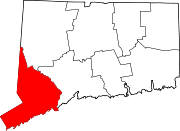Huntington Center Historic District
The area that is now Shelton was settled by English colonists in the 17th century as part of Stratford. In 1717 a Congregationalist parish was established, and in 1789 the town of Huntington was incorporated, including what is now neighboring Monroe. The site of the early parish became the center of the new town. In addition to its civic function, the area also developed some industry, powered by the waters of the Farmill River and Means Brook. In the second half of the 19th century, the community's industrial and civic focus shifted to the Housatonic River (its eastern border), and it was renamed Shelton in 1919 in honor of Edward Shelton, one of its major industrialists. Shelton's likely ancestral home still stands in Huntington Center.
Significant properties
- Huntington Green, 1717
- Josiah Wheeler House
- DeForest-Rudd House, c. 1770, Colonial
- Huntington Congregational Church, c. 1890, Gothic Revival
- St. Paul's Episcopal Church, 1812, Federal
See also
References
- ^ "National Register Information System". National Register of Historic Places. National Park Service. March 13, 2009.
- ^ Jan Cunningham (September 20, 1998). "National Register of Historic Places Inventory-Nomination: Huntington Center Historic District". National Park Service. and Accompanying 18 photos, from 1998 (captions on p. 20 of text document)
